Emilio Ghione (1879-1930) was an Italian silent film actor, director, and screenwriter. He is best known for writing, directing, and starring in a series of adventure films about Za La Mort, a likable French apache and 'honest outlaw.'

Italian postcard.

Italian postcard by G. Vettori, Bologna, no. 5. Emilio Ghione as Za la mort and Kally Sambucini as Za la vie in Za-la-Mort (Emilio Ghione, 1915).

Italian postcard by Ed. G. Vettori, Bologna, no. 2012. Photo: Ghione-Film. Emilio Ghione in La maga e il grifo (Emilio Ghione, 1922).

Italian postcard by Vettori, Bologna, no. 2011. Photo: Tiber Film / U.C.I. Emilio Ghione in Senza pietà/Without pity (Emilio Ghione, 1921).
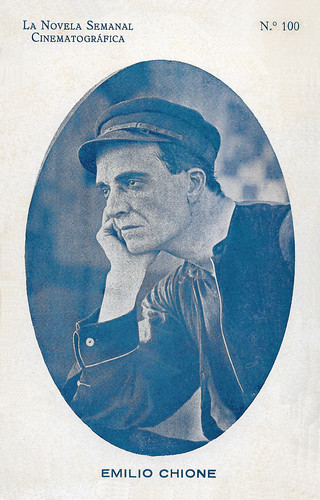
Spanish card by La Novela Semanal Cinematográfica, no. 100.
Emilio Ghione was born Emilio Luigi Carlo Giuseppe Maria Ghione in Turin, Italy in 1879. He was the son of painter Celestino Ghione, and he initially worked as a painter of miniatures himself. Ghione secured work in Turin's growing film industry in 1908, initially as a set-hand and stuntman, then playing secondary roles in all kinds of films mainly by Itala Film, including comedies with Cretinetti (André Deed). Frustrated by the slow progress of his career, Ghione moved to Rome in 1911. There he quickly obtained starring roles in films made by Cines and Celio-Film, such as Il poverello di Assisi (Enrico Guazzoni, 1911) in which he had the lead of St. Francis.
Ghione then starred in a series of films alongside Francesca Bertini and Alberto Collo, including Panne d’auto (1912), Terra promessa (1913), L’amazzone mascherata (1913) – all available at the Eye Institute (the Dutch Filmmuseum) - and Histoire d'un Pierrot (1914), all directed by Baldassarre Negroni. Ghione mostly played the bad guy in these films.
In 1913 Ghione directed his first film as actor-director, Il Circolo Nero, of which a print was rediscovered at the Eye Institute as well. Ghione became known for his success in directing the demanding divas of the period, including Lina Cavalieri, Francesca Bertini, and Hesperia. However, Ghione was not entirely able to resist their demands. Francesca Bertini allegedly ordered the destruction of all the prints of the Roberto Bracco adaptation Don Pietro Caruso (Emilio Ghione, 1914) because she didn’t like the outfits she wore in the film.
In 1914, Ghione created the first film featuring his character Za La Mort, Nelly La Gigolette (Emilio Ghione, 1914), which was a great success. As a consequence, Ghione moved to Tiber film, where he created a sequel around his character, Za La Mort (1915) as well. It also introduced his long-time companion on-screen, Za La Vie, played by Kally Sambucini, who also became Ghione’s private companion till his death. In 1911 Ghione married Clotilde Coletti and they had one son, Pierfrancesco Ghione, also known as Emilio Ghione Jr., but the couple separated after 1913. Ghione created thirteen Za La Mort feature films and three serial films between 1914 and 1924, many of which were very successful commercially, such as Anime buie (Emilio Ghione, 1916), Triangolo giallo (Emilio Ghione, 1917), I topi grigi (Emilio Ghione, 1918) and Dollari e fraks (Emilio Ghione, 1918).
The character of Za La Mort, a Parisian Apache, was unstable throughout the series. In some films, Za La Mort is a cruel-hearted, murderous, seductive criminal, while in others he is a romantic, faithful, underworld avenger, similar to Louis Feuillade's Judex. The Za La Mort series was mostly set in an imaginary Paris, with some episodes set in America and exotic tropical locations. Despite inconsistencies in plot and character and mostly negative critical reviews, Za La Mort's exotic, exciting adventures captured the public imagination and Ghione became one of the most recognisable stars of the Italian silent cinema. During the production of the Za La Mort series, Ghione continued to star in and direct a variety of films, including melodramas, adventure films, and propagandistic biopics: Cicueracchio (Emilio Ghione, 1916) and Oberdan (Emilio Ghione, 1916), both for Tiber Film.
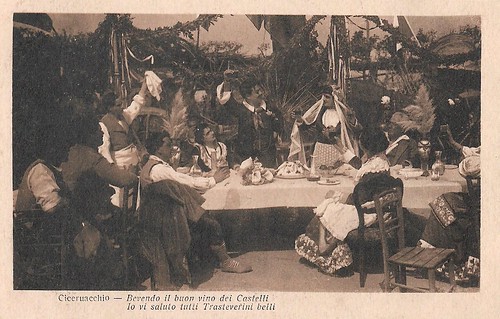
Italian postcard. Photo: Tiber Film. Gastone Monaldi as Cicueracchio in Ciceruacchio (Emilio Ghione, 1915). Caption: Drinking the wine of the Castelli [romani], I greet you all, beautiful people of Trastevere!

Italian postcard. Emilio Ghione (left) and Alberto Collo in Oberdan (Emilio Ghione, 1916). Caption: Guglielmo Oberdan: "I admit and I swear to have come to Trieste with the exact scope of killing the infamous head of an infamous state. And now I happily challenge your tortures."

Italian postcard. Alberto Collo and Vittorina Moneta in Oberdan (Emilio Ghione, 1916). Caption: Gugliemo Oberdan: "The Fatherland above all other affections. From this wet nurse Rome, queen of the world, the spark will part that will free my Trieste."

Italian postcard. Alberto Collo in Oberdan (Emilio Ghione, 1916). Caption: Guglielmo Oberdan: "I don't fear you, you cops. If only my act could cause Italy to start a war with the enemy."
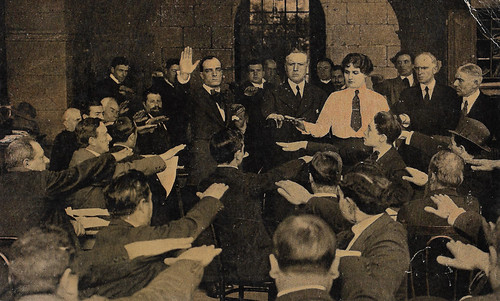
Spanish collectors card by Chocolate Pi, Barcelona, no. 2 of 6. Photo: Tiber Film. Hesperia and Emilio Ghione in Il potere sovrano (Baldassarre Negroni, Percy Nash, 1916). The Spanish title on the cards is Poder Soberano. Spanish distributor of the film: J. Verdaguer.
In the period 1919-1924, Emilio Ghione directed and starred in films for all kinds of Italian film companies including Tiber Film, Itala, and Lombardo (now known as Titanus). He even had his own company Ghione Film for a short time in 1922. Ghione Film coproduced films together with Pasquali Film and made the last film in 1924: Senza padre, which was only released in 1927. Ghione led a famously decadent life, following the trends set by poet Gabriele D'Annunzio. Ghione spent a lot of money on restaurants, generous tips, clothes, and antiques. Ghione was a fan of luxury automobiles made by Lancia and used them in his films. Ghione's decadent lifestyle and expensive habits left him nearly penniless when the Italian film industry collapsed in 1922.
In 1924, he left for Germany to direct his last Za La Mort film: Za La Mort-Der Traum der Za La Vie with daring femme fatale Fern Andra opposite Ghione and Sambuccini, but the film was a commercial failure, owing partially to the fact that it was extensively cut by the censors. Returned to Italy, Ghione played in two major productions with Soava Gallone, La via del peccato (Amleto Palermi, 1925) and La cavalcata ardente/The Fiery Cavalcade (Carmine Gallone, 1925). While he played an Apache and Sambuccini a Gigolette in the former film, Ghione had a major part as the bad guy in the latter. As the Borbonic Prince of Santafé, he pushes Grazia de Montechiaro (Soava Gallone) to marry him, but her lover, the patriot Giovanni (Gabriel de Gravone) manages to prevent this, with the help of the bandit Pasquale Noto (Raimondo Van Riel).
One of Ghione’s last parts was in the epic Gli ultimi giorni di Pompei/The Last Days of Pompei (Amleto Palermi, Carmine Gallone, 1926), which despite its ambitions to revive the glory of the Italian epics of the 1910s failed to revive the dying Italian film industry. Ghione remarked himself that it was rather The Last Days of Italian Cinema, instead of The Last Days of Pompei. He turned to the theatre instead. In 1926, Ghione launched a theatrical revue with Kally Sambucini and Alberto Collo and toured Italy performing sketches based on the Za La Mort films. Ghione was also active as a writer, exploiting his famous character. In 1922, Ghione's first Za La Mort novel, 'Le Maschere Bianche', was published in instalments in the popular Al Cinema magazine. Ghione published his second novel, 'Za La Mort', in 1928. The novel was largely based on the Za La Mort films, especially on the German one, the plot of which had been made almost unintelligible by censorship cuts.
Between March and December 1928 Ghione's autobiography 'Memorie e Confessioni' also appeared in the monthly cinema magazine Cinemalia. In 1927 Emilio Ghione was hospitalised because of tuberculosis. A public appeal was opened, and the money was used to help his recovery and to send him to Paris in search of work. During his stay in Paris in 1929, his health deteriorated and he had to go to hospital again. Actress Lina Cavalieri paid to send him back to Turin by train. Emilio Ghione died on 7 January 1930 in Rome, in the presence of Kally Sambucini and his son, Pierfrancesco Ghione. In 1930, another Za La Mort novel was published called 'L'Ombra di Za La Mort'. The novel's central character is Ghione/Za La Mort, a mix of Ghione's decadent star persona and his favourite character, and tells of his adventures across the world and his encounters with beautiful women.
In 1979, a retrospective of Ghione's films was held at the Venice Film Festival. In 2007 Vittorio Martinelli’s study 'Za La Mort. Ritratto di Emilio Ghione' appeared, edited by the Cineteca di Bologna. In 2008, a retrospective of his films was held at the Cinema Ritrovato festival in Bologna, a temporary exhibition of photographs and film stills documenting Ghione's career was opened at the Cineteca of Bologna, and Denis Lotti’s monography on Emilio Ghione appeared: 'Emilio Ghione. L’ultimo apache. Vita e film di un divo italiano' (2008).

Italian postcard by G.B. Falci Editore, Milano (La Fotominio), no. 364. Photo: A.P. Film. Emilio Ghione and Kally Sambucini in La via del peccato (Amleto Palermi, 1925). Sambucini's first name is misspelt on the card.
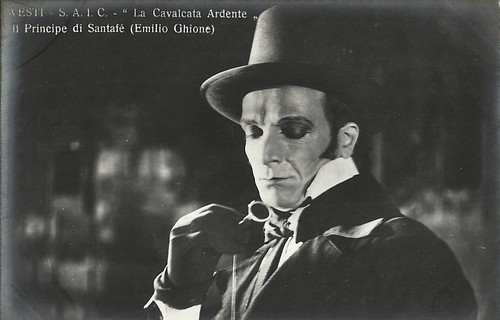
Italian postcard by Ed. A. Traldi, Milano. Photo: Westi SAIC. Emilio Ghione as the Prince of Santafé in La cavalcata ardente/The Fiery Cavalcade (Carmine Gallone, 1925).
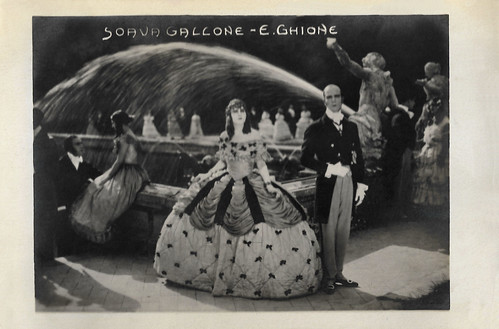
Italian postcard by Eureka. Sent by mail in 1927. Soava Gallone and Emilio Ghione in La cavalcata ardente/The Fiery Cavalcade (Carmine Gallone, 1925).

At the Cinema Ritrovato Festival in Bologna, June-July 2008, the exhibition 'L'Ultimo Apache' was dedicated to Ghione. Here you see the Cineteca, Bologna, with the two Lumière cinemas.
Sources: Vittorio Martinelli (Za La Mort. Ritratto di Emilio Ghione), Denis Lotti (Emilio Ghione. L’ultimo apache. Vita e film di un divo italiano), Wikipedia (English and Italian) and IMDb.
This post was last updated on 16 May 2024.

Italian postcard.

Italian postcard by G. Vettori, Bologna, no. 5. Emilio Ghione as Za la mort and Kally Sambucini as Za la vie in Za-la-Mort (Emilio Ghione, 1915).

Italian postcard by Ed. G. Vettori, Bologna, no. 2012. Photo: Ghione-Film. Emilio Ghione in La maga e il grifo (Emilio Ghione, 1922).

Italian postcard by Vettori, Bologna, no. 2011. Photo: Tiber Film / U.C.I. Emilio Ghione in Senza pietà/Without pity (Emilio Ghione, 1921).

Spanish card by La Novela Semanal Cinematográfica, no. 100.
Bad guy
Emilio Ghione was born Emilio Luigi Carlo Giuseppe Maria Ghione in Turin, Italy in 1879. He was the son of painter Celestino Ghione, and he initially worked as a painter of miniatures himself. Ghione secured work in Turin's growing film industry in 1908, initially as a set-hand and stuntman, then playing secondary roles in all kinds of films mainly by Itala Film, including comedies with Cretinetti (André Deed). Frustrated by the slow progress of his career, Ghione moved to Rome in 1911. There he quickly obtained starring roles in films made by Cines and Celio-Film, such as Il poverello di Assisi (Enrico Guazzoni, 1911) in which he had the lead of St. Francis.
Ghione then starred in a series of films alongside Francesca Bertini and Alberto Collo, including Panne d’auto (1912), Terra promessa (1913), L’amazzone mascherata (1913) – all available at the Eye Institute (the Dutch Filmmuseum) - and Histoire d'un Pierrot (1914), all directed by Baldassarre Negroni. Ghione mostly played the bad guy in these films.
In 1913 Ghione directed his first film as actor-director, Il Circolo Nero, of which a print was rediscovered at the Eye Institute as well. Ghione became known for his success in directing the demanding divas of the period, including Lina Cavalieri, Francesca Bertini, and Hesperia. However, Ghione was not entirely able to resist their demands. Francesca Bertini allegedly ordered the destruction of all the prints of the Roberto Bracco adaptation Don Pietro Caruso (Emilio Ghione, 1914) because she didn’t like the outfits she wore in the film.
In 1914, Ghione created the first film featuring his character Za La Mort, Nelly La Gigolette (Emilio Ghione, 1914), which was a great success. As a consequence, Ghione moved to Tiber film, where he created a sequel around his character, Za La Mort (1915) as well. It also introduced his long-time companion on-screen, Za La Vie, played by Kally Sambucini, who also became Ghione’s private companion till his death. In 1911 Ghione married Clotilde Coletti and they had one son, Pierfrancesco Ghione, also known as Emilio Ghione Jr., but the couple separated after 1913. Ghione created thirteen Za La Mort feature films and three serial films between 1914 and 1924, many of which were very successful commercially, such as Anime buie (Emilio Ghione, 1916), Triangolo giallo (Emilio Ghione, 1917), I topi grigi (Emilio Ghione, 1918) and Dollari e fraks (Emilio Ghione, 1918).
The character of Za La Mort, a Parisian Apache, was unstable throughout the series. In some films, Za La Mort is a cruel-hearted, murderous, seductive criminal, while in others he is a romantic, faithful, underworld avenger, similar to Louis Feuillade's Judex. The Za La Mort series was mostly set in an imaginary Paris, with some episodes set in America and exotic tropical locations. Despite inconsistencies in plot and character and mostly negative critical reviews, Za La Mort's exotic, exciting adventures captured the public imagination and Ghione became one of the most recognisable stars of the Italian silent cinema. During the production of the Za La Mort series, Ghione continued to star in and direct a variety of films, including melodramas, adventure films, and propagandistic biopics: Cicueracchio (Emilio Ghione, 1916) and Oberdan (Emilio Ghione, 1916), both for Tiber Film.

Italian postcard. Photo: Tiber Film. Gastone Monaldi as Cicueracchio in Ciceruacchio (Emilio Ghione, 1915). Caption: Drinking the wine of the Castelli [romani], I greet you all, beautiful people of Trastevere!

Italian postcard. Emilio Ghione (left) and Alberto Collo in Oberdan (Emilio Ghione, 1916). Caption: Guglielmo Oberdan: "I admit and I swear to have come to Trieste with the exact scope of killing the infamous head of an infamous state. And now I happily challenge your tortures."

Italian postcard. Alberto Collo and Vittorina Moneta in Oberdan (Emilio Ghione, 1916). Caption: Gugliemo Oberdan: "The Fatherland above all other affections. From this wet nurse Rome, queen of the world, the spark will part that will free my Trieste."

Italian postcard. Alberto Collo in Oberdan (Emilio Ghione, 1916). Caption: Guglielmo Oberdan: "I don't fear you, you cops. If only my act could cause Italy to start a war with the enemy."

Spanish collectors card by Chocolate Pi, Barcelona, no. 2 of 6. Photo: Tiber Film. Hesperia and Emilio Ghione in Il potere sovrano (Baldassarre Negroni, Percy Nash, 1916). The Spanish title on the cards is Poder Soberano. Spanish distributor of the film: J. Verdaguer.
Decadent lifestyle
In the period 1919-1924, Emilio Ghione directed and starred in films for all kinds of Italian film companies including Tiber Film, Itala, and Lombardo (now known as Titanus). He even had his own company Ghione Film for a short time in 1922. Ghione Film coproduced films together with Pasquali Film and made the last film in 1924: Senza padre, which was only released in 1927. Ghione led a famously decadent life, following the trends set by poet Gabriele D'Annunzio. Ghione spent a lot of money on restaurants, generous tips, clothes, and antiques. Ghione was a fan of luxury automobiles made by Lancia and used them in his films. Ghione's decadent lifestyle and expensive habits left him nearly penniless when the Italian film industry collapsed in 1922.
In 1924, he left for Germany to direct his last Za La Mort film: Za La Mort-Der Traum der Za La Vie with daring femme fatale Fern Andra opposite Ghione and Sambuccini, but the film was a commercial failure, owing partially to the fact that it was extensively cut by the censors. Returned to Italy, Ghione played in two major productions with Soava Gallone, La via del peccato (Amleto Palermi, 1925) and La cavalcata ardente/The Fiery Cavalcade (Carmine Gallone, 1925). While he played an Apache and Sambuccini a Gigolette in the former film, Ghione had a major part as the bad guy in the latter. As the Borbonic Prince of Santafé, he pushes Grazia de Montechiaro (Soava Gallone) to marry him, but her lover, the patriot Giovanni (Gabriel de Gravone) manages to prevent this, with the help of the bandit Pasquale Noto (Raimondo Van Riel).
One of Ghione’s last parts was in the epic Gli ultimi giorni di Pompei/The Last Days of Pompei (Amleto Palermi, Carmine Gallone, 1926), which despite its ambitions to revive the glory of the Italian epics of the 1910s failed to revive the dying Italian film industry. Ghione remarked himself that it was rather The Last Days of Italian Cinema, instead of The Last Days of Pompei. He turned to the theatre instead. In 1926, Ghione launched a theatrical revue with Kally Sambucini and Alberto Collo and toured Italy performing sketches based on the Za La Mort films. Ghione was also active as a writer, exploiting his famous character. In 1922, Ghione's first Za La Mort novel, 'Le Maschere Bianche', was published in instalments in the popular Al Cinema magazine. Ghione published his second novel, 'Za La Mort', in 1928. The novel was largely based on the Za La Mort films, especially on the German one, the plot of which had been made almost unintelligible by censorship cuts.
Between March and December 1928 Ghione's autobiography 'Memorie e Confessioni' also appeared in the monthly cinema magazine Cinemalia. In 1927 Emilio Ghione was hospitalised because of tuberculosis. A public appeal was opened, and the money was used to help his recovery and to send him to Paris in search of work. During his stay in Paris in 1929, his health deteriorated and he had to go to hospital again. Actress Lina Cavalieri paid to send him back to Turin by train. Emilio Ghione died on 7 January 1930 in Rome, in the presence of Kally Sambucini and his son, Pierfrancesco Ghione. In 1930, another Za La Mort novel was published called 'L'Ombra di Za La Mort'. The novel's central character is Ghione/Za La Mort, a mix of Ghione's decadent star persona and his favourite character, and tells of his adventures across the world and his encounters with beautiful women.
In 1979, a retrospective of Ghione's films was held at the Venice Film Festival. In 2007 Vittorio Martinelli’s study 'Za La Mort. Ritratto di Emilio Ghione' appeared, edited by the Cineteca di Bologna. In 2008, a retrospective of his films was held at the Cinema Ritrovato festival in Bologna, a temporary exhibition of photographs and film stills documenting Ghione's career was opened at the Cineteca of Bologna, and Denis Lotti’s monography on Emilio Ghione appeared: 'Emilio Ghione. L’ultimo apache. Vita e film di un divo italiano' (2008).

Italian postcard by G.B. Falci Editore, Milano (La Fotominio), no. 364. Photo: A.P. Film. Emilio Ghione and Kally Sambucini in La via del peccato (Amleto Palermi, 1925). Sambucini's first name is misspelt on the card.

Italian postcard by Ed. A. Traldi, Milano. Photo: Westi SAIC. Emilio Ghione as the Prince of Santafé in La cavalcata ardente/The Fiery Cavalcade (Carmine Gallone, 1925).

Italian postcard by Eureka. Sent by mail in 1927. Soava Gallone and Emilio Ghione in La cavalcata ardente/The Fiery Cavalcade (Carmine Gallone, 1925).

At the Cinema Ritrovato Festival in Bologna, June-July 2008, the exhibition 'L'Ultimo Apache' was dedicated to Ghione. Here you see the Cineteca, Bologna, with the two Lumière cinemas.
Sources: Vittorio Martinelli (Za La Mort. Ritratto di Emilio Ghione), Denis Lotti (Emilio Ghione. L’ultimo apache. Vita e film di un divo italiano), Wikipedia (English and Italian) and IMDb.
This post was last updated on 16 May 2024.
No comments:
Post a Comment